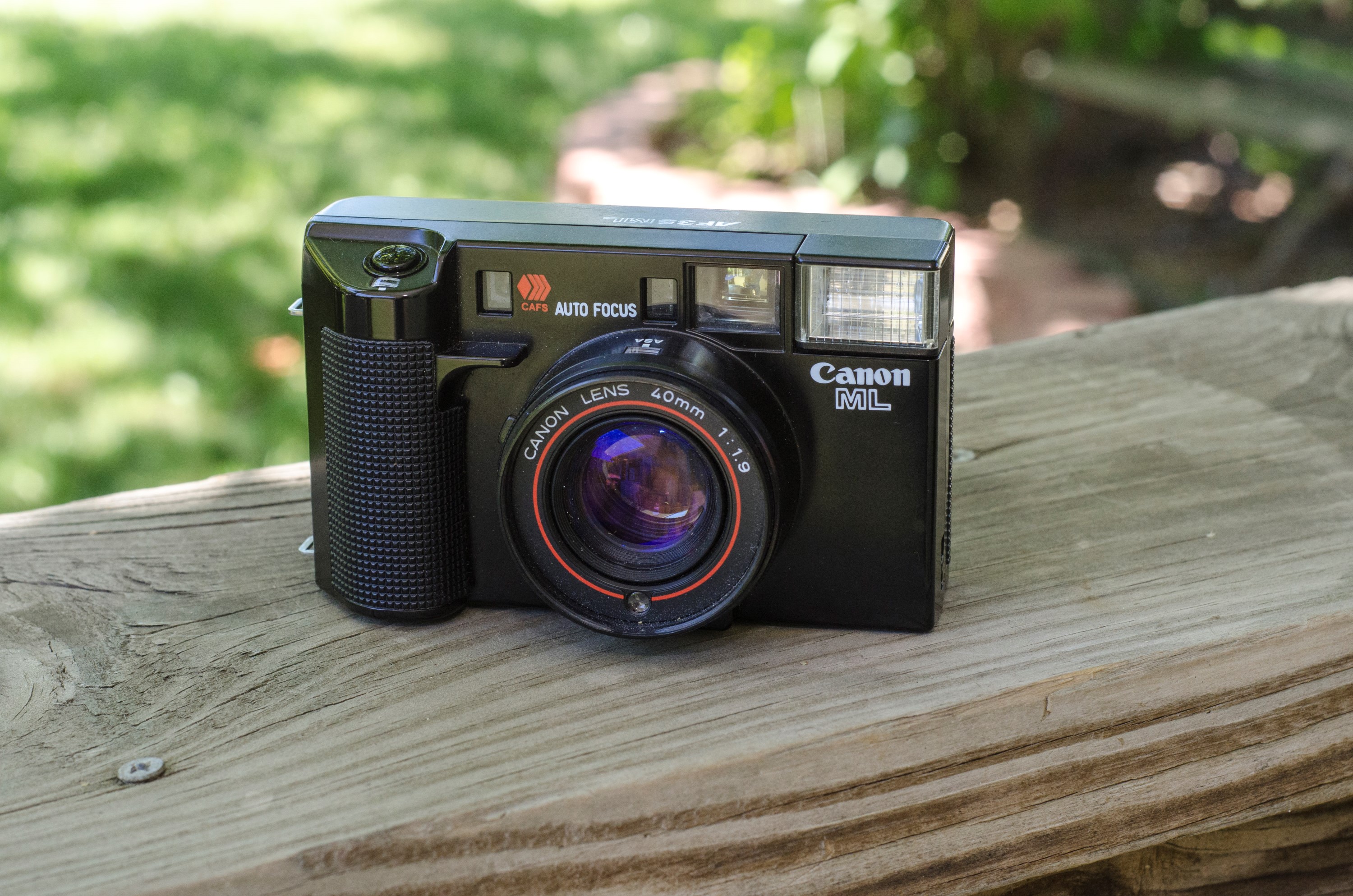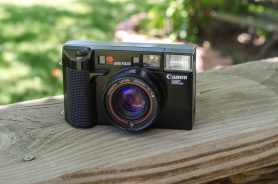This is a Canon AF35ML 35mm auto focus camera made by Canon in 1981. This camera was also known as the Super Sure Shot in the US and the Autoboy Super in Japan. The AF35ML was the follow up to Canon’s earlier AF35M auto focus camera. It improved upon that model by offering a fast f/1.9 lens, plus a larger grip, and improved self timer. The changes weren’t all good however, it had a more primitive passive auto focus system and a slower 1/400 top shutter speed (compared to 1/500 on the AF35M). Still, it remained a popular cross over camera for people wishing for a fully automatic point and shoot camera, but with a very fast and sharp f/1.9 5-element lens.
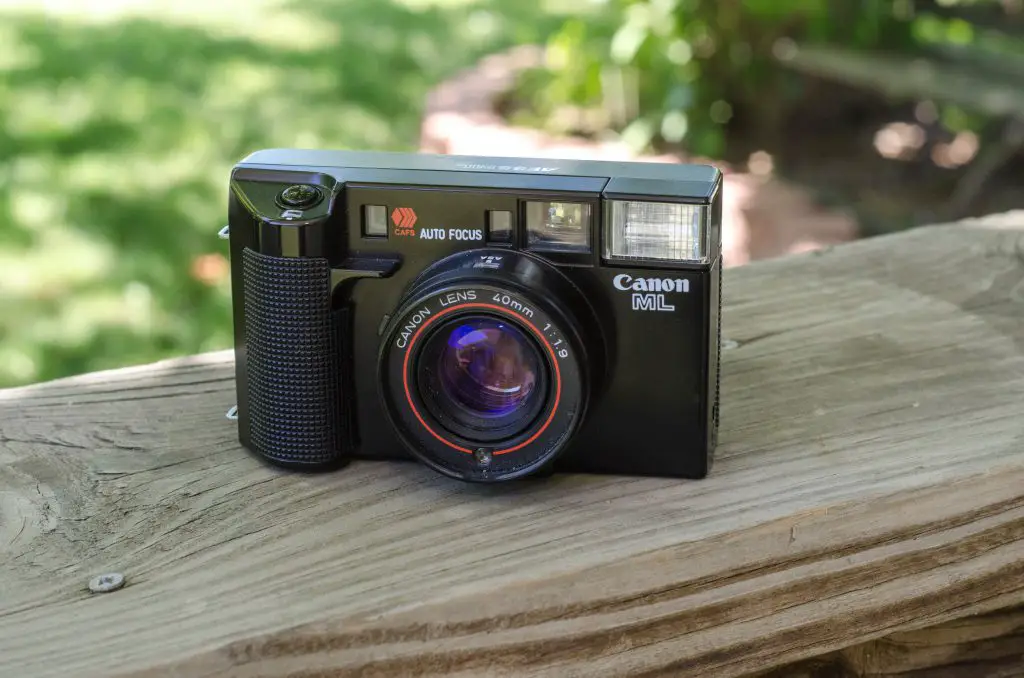 Film Type: 135 (35mm)
Film Type: 135 (35mm)
Lens: Canon 40mm f/1.9 Coated 5-elements
Focus: Passive CCD Triangulation Auto Focus
Shutter: Electronic Leaf
Speeds: 1/4 – 1/400 seconds, stepless
Exposure Meter: Full Program CdS meter
Battery: 2 x AA 1.5v Alkaline
Flash: Built-in Popup Flash
Manual: http://www.cameramanuals.org/canon_pdf/canon_af_35ml.pdf
How these ratings work |
The Canon AF35ML was Canon’s second auto focus camera and the successor to the wonderful AF35M. It remains one of the only point and shoot autofocus cameras ever made with an f/1.9 lens. It has a comfortable and easy to hold body, runs on easy to find AA batteries, and when it works properly, shoots images that are sharp and beautifully rendered. The big issue here is the extremely disappointing auto focus system. I acknowledge that there could possibly be a technical problem with my camera, but unless I get another example (unlikely) of this camera that does a better job, I can’t recommend this camera. Sure, its pretty looking, and who wouldn’t want an f/1.9 lens in a “walk around” candid camera, but the camera really struggled for me. | ||||||
| Images | Handling | Features | Viewfinder | Feel & Beauty | History | Age | |
| 0 | 2 | 1 | 0 | 1 | 0 | 0% | |
| Bonus | +1, I give this camera a ‘0’ for Images because of how often the autofocus ruined the images, but I’ll add back a bonus point to acknowledge that when the camera did focus correctly, the 5-element f/1.9 lens was quite sharp | ||||||
| Final Score | 5.0 | ||||||
History
The history of this camera follows closely to that of the Canon AF35M which I have previously reviewed on this site. That review can be found here.
Building upon the success of the AF35M, in 1981, Canon would release this AF35ML. The most obvious change was the f/1.9 5-element lens. Other changes were the larger and more prominent hand grip, an improved self timer, and a revised viewfinder. It still would run on two AA batteries, had a popup flash, and no manual control. The camera was completely automatic.
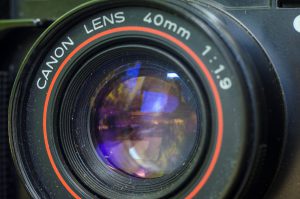
If Canon would have stopped here, the camera most likely would have been a winner, but they didn’t. No, they made one more change which was to abandon the AF35M’s advanced active triangulating infra-red auto focus system, and replaced it with a much more simpler passive system which used a traditional two window rangefinder with twin CCD eyes that would attempt to “see” focus and adjust the camera as necessary.
Edit: After writing this review, I found an article in the September 1981 issue of Popular Photography that suggests that the “new” twin window CCD system was actually more advanced than the infra-red system in the AF35M.
Perhaps this system helped keep costs low, or Canon really thought the system on the AF35M was unnecessary, but whatever the reason, Canon improved upon this camera with a larger and brighter lens, a larger and easier to use handgrip, but then crippled it with a less advanced auto focus system. One that was more similar to the earlier Konica “Visitronic” system that Canon worked hard to criticize when they released the original AF35M.
My Thoughts
When I first started collecting film cameras, my interest was limited to older, manual cameras. I had no interest in these plastic point and shoot models from the 1980s. I was gifted a Canon AF35M by the parents of a good friend and thought I’d give it a shot. As it turns out, using that camera was a pleasant experience, and once I saw the first shots from it, my fondness for it grew. Almost every shot from that first roll came out very nicely. I was impressed that such a basic camera could produce such nice shots. I thought, if this one can do a good job, why not try another?
I found this AF35ML on eBay with a starting bid of $9.99. I won the camera as the only bidder. When it arrived, I was pleased to see that it was in great physical shape. The battery compartment had no corrosion and upon putting in two fresh AA batteries, the camera fired up and appeared to do everything it should. I gave it a quick wipe down with some rubbing alcohol, loaded in some film, and took it with me on a family trip to Seattle.
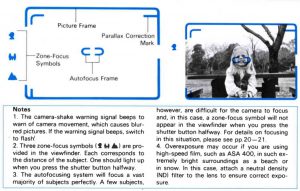
Shooting with both the AF35M and AF35ML are very similar to each other. The viewfinder is a little different in the AF35ML. The most obvious difference is the absence of the useless scale on the bottom of the viewfinder of the AF35M. Instead, you have equally useless LED indicators on the left side of the frame. Neither camera has automatic parallax correction, instead you have a second set of parallax lines for composing at close focus.
Also similar between the two cameras is the center autofocus indicator. Both cameras are limited in focusing on things in the very center of the frame. If you want to focus on something that is not in the center, you must first have your focal point in the center of the frame, half press the shutter release button until one of the focus indicators lights up, and while still holding down the shutter release half way, move the camera to your desired composition. The camera should retain focus on what was originally in the center of the frame. This is one of the ways in which the AF35ML improved upon the earlier model which required a convoluted “Pre-Focus” mode of the self timer switch to accomplish the same thing.
While flipping through the AF35ML’s manual, it warns you that the camera may struggle with “a few subjects”. The manual kindly tells you to turn to page 20 of the manual to read about these special circumstances.

The image to the right shows the complete list of situations in which the AF sensor might have difficulty. They are:
- Subjects without vertical lines
- Subjects with low contrast
- Subjects with objects in front of them
- Subjects with strong reflections
- Subjects with brightly backlit backgrounds
- Subjects composed of very small, uniform parts
When reading this list, I have to think that this isn’t exactly “a few”. Many situations could fall into one of these categories. How much would this affect the camera’s ability to automatically focus on candid photos?
As for the rest of the camera, the experience is very similar to that of the AF35M, so you can read that review for more specifics. The popup flash here still has a very long recycling time like the earlier model. You need to wait for the flash ready light to illuminate before taking a picture. This is not a TTL (Through the Lens) camera, so you have to remember to take the lens cap off the camera before trying to use the camera. Both cameras have a limited range of ASA film speeds from 25 – 400 to choose from so don’t attempt to use anything faster than 400 speed film. Finally, you have to remember to turn the camera to the “ON” position before trying to use it.
My Results
I’m keeping this review short mostly because of how frustrated I became after seeing the results of my first test roll. It’s hard to sit here and type up a thorough description of my thoughts about the camera and give you an idea of what it was like to use it, knowing that the results I got from it were so inconsistent.
I’ll start off with the good. Some of the images I received were quite nice and showed what the f/1.9 5-element lens is capable of. Between the following 12 shots in this review, the film stock used was half fresh FujiColor 400 and half expired Kodak Max 400. The shots on the expired Kodak are noticeably more grainy and a tad underexposed, but I will not fault the camera for that.
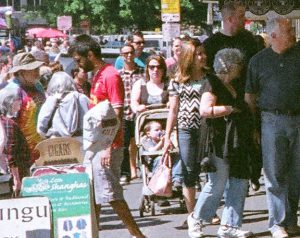
The most impressive shot is the one of the man playing guitar while using a hula hoop at the same time. This was shot outdoors in bright sunlight with a moving subject. The landscape shot of the mountains at infinity also turned out nice. The images are consistently sharp in the center and around the corners. There is a tad bit of vignetting at the corners in the mountains shot and the one of the children playing on the railroad, but it doesn’t show in all images. I don’t see any chromatic abberations as well, which I wouldn’t expect from a 5 element lens.
The image to the left is a 1:1 crop just off center of the 6th picture above. The details of the baby holding the purple sippy cup are very strong. You can even read the word “Cigars” on the wooden sign right in front of the man in the red shirt. This lens is clearly quite good, and definitely better than ones found on most plastic point and shoot cameras from the 1980s.
Had more images turned out like these first 6, this review would be very different, but sadly, they didn’t.
The word “inconsistent” pretty much sums up this whole review as the images were a “Russian Roulette” like smorgasbord of in and out of focus images. The “few subjects” that the manual warns you about turn out to be “many subjects”.
I have many more shots than just these 6 that were out of focus. Some only slightly, but others were significantly out of focus. The camera really seemed to struggle with focus on interior shots, which is completely crazy since one of the greatest benefits of a fast f/1.9 lens is for shooting indoors. I did not get a single indoor shot in focus from the 2 rolls I shot in this camera. Not even the one of the bar above. I had the camera centered on the lady in the turquoise shirt, and nothing in this image is in focus.
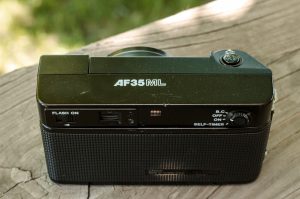
The shot of the gum on the wall might have fallen into the realm of “Subjects composed of very small, uniform parts” like the manual warned me. The thing is, this was a flat wall, with a very consistent focal plane. This image was shot in shadows, but they were very brightly lit outdoor shadows. There is no reason the camera should have struggled with this shot.
The Ferris wheel image has tons of vertical lines. Maybe you have to have only vertical lines, and no diagonal ones.
In the shot of the bicycles, I had the camera centered on the bikes near the back, yet none of them came out in focus.
Perhaps, the most disappointing ones are the first two in the Seattle fish market. I love the composition of these, and had I used a more capable camera, these could have been highlights of the roll. Instead, nothing is in focus. I do not understand how this camera can even be considered an auto focus camera when it is so easily tricked. The worst part is that Canon had a more capable auto focus system that most likely would have done better on most of these shots.

If it was 1981, and I was in the market for an easy to use vacation camera that had a great lens and could take the guess work out of focusing, and I purchased this camera and seen these results, I would have not been happy. The September 1981 issue of Popular Photography lists the MSRP of this camera as being “just under $300”. Assuming that means $299.95 in 1981 dollars, when adjusted for inflation this would be comparable to a camera costing $792 today.
This same article suggests that the reviewer ran into some difficulty with the auto focus system, but that she was able to overcome “most” situations. She goes on to say that for “general, everyday shooting, the auto focus system worked admirably well”.
Based on my experience, I don’t know that I would use the terms “admirably well” when referring to the AF35ML’s ability to automatically focus. I figured that one of two things must be true here. Either, the expectations of what an auto focus system could do in 1981 is much less than what we expect today, or there is a chance something is wrong with my particular example. This is a nearly 35 year old camera after all, so maybe I should be more forgiving. Also, when reading other recent reviews of this camera like those from Ken Rockwell and Matt Denton, they didn’t seem to struggle with the auto focus system like I did.
Looking at my results from the earlier, AF35M, I was very happy with what I got. Sure, even that camera didn’t get focus right 100% of the time, but considering this camera was the successor of that model and sold for nearly the equivalent of an $800 camera today, I expect more. I have no reason to indicate that anything is wrong with my particular example, but maybe there is. I don’t know that I’ll ever shoot with it again, but if I do, maybe I can try some more controlled situations where I can use the auto focus system to it’s strengths.
Additional Resources
http://mattsclassiccameras.com/canon_af35ml.html
http://camerapedia.wikia.com/wiki/Canon_Super_Sure_Shot/AF35ML/Autoboy_Super
http://global.canon/en/c-museum/product/film104.html
http://www.kenrockwell.com/canon/sure-shot/af35ml.htm
https://books.google.com/books?id=txFmVbE2EoUC&pg=PA107#v=onepage&q&f=false

